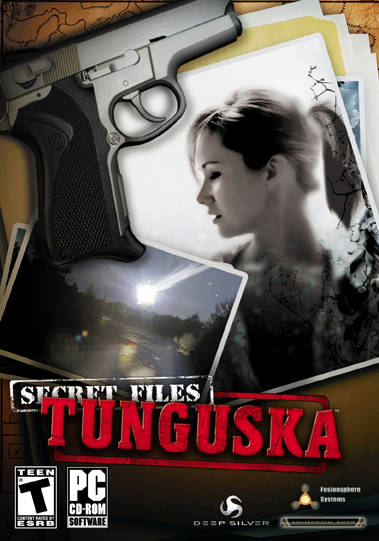You can trust VideoGamer. Our team of gaming experts spend hours testing and reviewing the latest games, to ensure you're reading the most comprehensive guide possible. Rest assured, all imagery and advice is unique and original. Check out how we test and review games here
Ahh the point and click adventure. Those were the days. When games were games and you didn’t have to plod about as a muscle-bound meat head shooting aliens in the face just to get by. But, like 80’s cartoons, the genre as a whole enjoys a reputation it perhaps doesn’t deserve. Some point and clicks were absolutely stunning (Monkey Island, Sam & Max) for sure, but, being frank, most were simply average. Secret Files: Tunguska, a point and click sleuth adventure, falls somewhere between the two.
It’s out now on Wii, what some are saying is the new home of the point and click adventure (see the charming Zack & Wiki and upcoming Sam & Max Season 1), and NDS, but Secret Files originally began life on PC in late 2006. If we’re honest, the whole event passed us by – perhaps we were distracted by the European release of the Wii itself. So this is our first bite of the Secret Files pie, and while it hasn’t exactly left a sour taste in our mouth it hasn’t set our taste buds alight either.
First off, the premise. Tunguska is a place in Russia that saw a massive explosion in June 30, 1908. We really do mean massive – about 1000 times as powerful as the bomb dropped on Hiroshima. The game begins with a little blurb that tells the story, but it claims the event is unexplained. While that’s technically true (scientists say it was almost certainly caused by an asteroid or comet) it’s not exactly the mystery the game suggests it is. Oh well. That’s being overly picky we suppose.
Anyway, you play Nina Kalenkov, a foxy motorbike mechanic from Berlin with a seriously annoying American accent. She turns up at the local natural history museum to find her scientist father missing and his office ransacked. It’s up to Nina to find out what happened to her ‘Daddy’, as she calls him, and unravel the mystery of the 1908 Tunguska explosion, something ‘Daddy’ has been doing a little digging on himself.
This being a point and click adventure game, there’s plenty of pointing and clicking, so to speak, with the Wii Remote. For the most part the controls work extremely well (except with Nina’s motorbike – the motorbike compartment and motorbike seat are so close together it’s almost impossible to select the one you want). Move the little on-screen Wii Remote over something then press B to check it out or A to interact with it. The d-pad is used to cycle through items in Nina’s bottomless pit of an inventory – we guess those tight jeans pockets are deceptively… er, tight – and 1 uses the magnifying glass, automatically displaying all the areas that can be interacted with.
The magnifying glass is a blessing and a curse. While it’s great to be able to quickly see all of the background items up for interaction (the resolution of the Wii sometimes makes it hard to spot small objects), it’s all too easy to simply use it to spot every object as soon as you enter a new pre-rendered area. It feels a bit cheap and it makes the game easier than it might have been.
We also found that puzzle solving was, on the whole (Tom had to help me out with one brain bender, something I’m sure he’ll remind me about at every available occasion) less about mental strength and more about monotonous trial and error. Simply trying to combine everything in your inventory with everything the magnifying glass identifies works with the selected item, as well as other items in your inventory, usually results in a problem solved so quickly Stephen Hawking would be impressed. This is, of course, one of the draw backs of the genre, but then it doesn’t mean we shouldn’t get upset about it.
A case in point. By trying to use everything in Nina’s inventory with everything in Nina’s inventory I was able to fashion a makeshift brailer (no, we had no idea what it was – it’s a fish net) by employing the technique above with a blue plastic bag, a bucket handle and a broom stick. We had no idea we were going to make a brailer, nor had we any idea why we needed one at the time. Ah well.
But then there are some pretty cool puzzles that had us scratching our heads for a good few minutes. One, which sees Nina trying to work out her father’s computer password from a mysterious voice recording, gave us that classic point and click puzzle solved satisfaction you get from a well thought out brain tease.
The story is actually quite intriguing, but it’s let down by some truly awful voice acting and cringe-worthy dialogue. Nina has an awful Paris Hilton accent which seems completely bizarre considering she was raised in Berlin. In fact every character has an American accent, which, given that the game begins in Berlin and, at least at the start, features almost exclusively German characters, jars. The graphics are basic at best, with poor character models, average pre-rendered backgrounds and uninspiring cut scenes. It’s not bad, per se, it’s just that we know the Wii can do better than this (once again, see the charming Zack & Wiki).
The Wii being what it is, many of the complaints we’ve described won’t bother those among the game’s target audience – casual gamers. If you can forgive its failings you’ll unearth a good Da Vinci Code-style detective story that should keep you going for a weekend at the very least. It’s better in almost all respects to the similar Wii PC port Agatha Christie: And Then There Were None, but doesn’t quite do enough for us to recommend it. Secret Files is worth a punt if the point and click genre floats your boat. Otherwise rent.
Secret Files: Tunguska
- Platform(s): Android, iOS, Nintendo DS, Nintendo Switch, PC, Wii, Wii U
- Genre(s): Adventure, Family

/https://oimg.videogamer.com/images/7a53/secret_files_tunguska_3-55607.jpg)
/https://oimg.videogamer.com/images/a5c8/secret_files_tunguska_1-55605.jpg)






